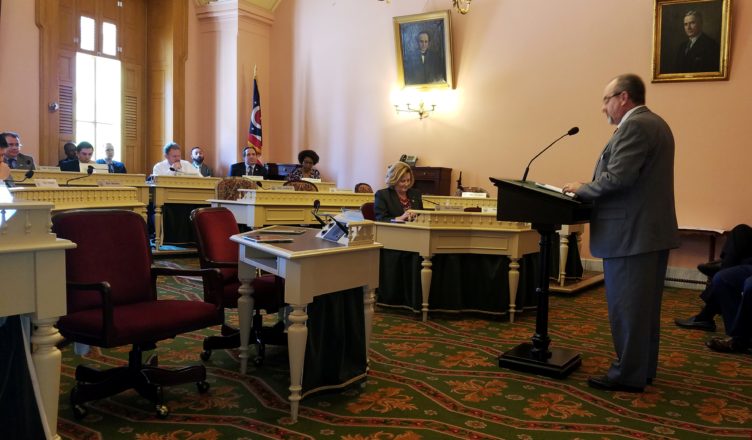COLUMBUS, Ohio — Guernsey County Commissioner Dave Wilson and Guernsey County Engineer Paul Sherry were among several Eastern Ohio government and business officials providing testimony to the Ohio House Ways and Means Committee this past Tuesday in support of proposed oil and gas severance tax legislation.
House Bill 105, if passed, would cap the state’s Oil and Gas Well Fund revenue at no more than $18 million annually, with the remainder distributed to counties, townships, municipalities and other entities.
According to current estimates, fiscal 2017 revenues will exceed $52 million. The bill’s passage could result in more than $34 million in excess revenue that could be transferred to political subdivisions for various purposes encompassed by the legislation.
The bill is co-sponsored by State Representatives Brian Hill and Jack Cera.
House Bill 105 designates 70% of the excess revenue for local governments within Ohio’s “shale region.” The bill requires the Director of the Ohio Department of Natural Resources to calculate the number of producing wells in each such county as a proportion of the total number of such wells in all such counties. The Director must then certify each county’s proportionate shale activity by June 15 of each year to the Office of Budget and Management (OBM) and the State Fire Marshal to enable them to distribute excess Oil and Gas Well Fund revenue.
Based on calendar year 2016 production reports, the “shale region” includes 17 counties. Those counties and their respective proportionate shale activity include: Carroll (30.7%), Harrison (19.3%), Belmont (14.1%), Monroe (10.3%), Noble (8.6%), Guernsey (8.6%), Columbiana (4.3%), Jefferson (1.9%), Mahoning (0.8%), Washington (0.4%), Tuscarawas (0.4%), Trumbull (0.2%), Stark, Morgan, Coshocton, Portage, and Muskingum (0.1% each).
The bill is intended to support capital improvement projects, road construction and maintenance, and the purchase of firefighting and EMT equipment and vehicles.
Also of note, over $10-million in excess revenue could be distributed annually to counties, townships, and municipalities with injection wells to support capital improvement projects and supplement general funds. A portion of this total would also be used to provide grants to specified entities, including state agencies, counties, townships, municipal corporations, and school districts to purchase or convert vehicles to use specified alternative fuels.
In his testimony, Wilson stressed the importance of the bill’s passage by expressing to the committee the financial challenges faced by Guernsey County. “While we as a Board of Commissioners would love to supply additional roadway funding from our county’s General Fund,” the Commissioner President told the legislators, “we are operating under a one-point-two million dollar budget deficit for the second straight year.”
Wilson pointed out two major items that could nearly double that deficit total, including the loss of sales tax revenue from Medicaid Managed Care Organizations, totaling over $720,000 annually and the nearly $400,000 in increased expense for Guernsey County’s 911 Center in order to comply with an unfunded mandate from the State of Ohio.
Sherry’s comments focused on the challenges of maintaining 400-miles of county roads and 313 bridges that carry both county and township road traffic. “Once the cost of plowing, mowing and drainage maintenance is accounted for,” Sherry explained to the committee, “there is only $1.2-million left for capital investment in the transportation infrastructure.”
Placing the cost of resurfacing a mile of roadway at around $140,000 and replacing a simple, short bridge at near $250,000, Sherry illustrated how insufficient the existing his office’s existing dollars are.
“Grant funds are scarce, competitive and require a shared amount of match money,” said Sherry. Many roads and bridges do not qualify for funding and even having adequate resources to match the grant is a sizable challenge.”
Wilson echoed the Engineer, “Roads that once had a solid surface from years of maintained chip and seal have regressed to gravel and stone. The increased cost of emulsion prohibits even basic dust control, leaving homeowners – quite literally – in the dust with homes, structures, vehicles and property covered in brown powder.”






